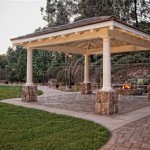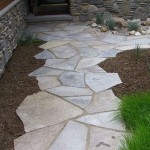How To Clean A Cement Patio Without A Power Washer
Cement patios, prized for their durability and versatility, serve as outdoor living spaces for relaxation, entertainment, and a connection with nature. However, their porous nature makes them susceptible to accumulating dirt, stains, mold, and mildew. While power washers offer a quick cleaning solution, they can potentially damage the cement surface if used improperly. Furthermore, not everyone has access to or prefers to use a power washer. This article provides detailed instructions on how to effectively clean a cement patio without resorting to a power washer, ensuring its longevity and aesthetic appeal.
The method for cleaning a cement patio without a power washer involves a combination of scrubbing, appropriate cleaning solutions, and diligent rinsing. The key is understanding the types of stains and dirt present, and selecting the right cleaning agents and techniques accordingly. Ignoring proper cleaning procedures or using harsh chemicals can lead to surface deterioration or discoloration. Therefore, patience and a systematic approach are essential for achieving optimal results.
Preparation is Key: Assembling Your Cleaning Arsenal
Before embarking on the cleaning process, gathering the necessary tools and materials is crucial for efficiency. This preparation involves assessing the patio's condition, identifying the types of stains present, and selecting appropriate cleaning agents. Failure to adequately prepare can result in a less effective cleaning or even damage to the cement surface.
First, sweep the entire patio area thoroughly to remove loose debris such as leaves, twigs, dirt, and cobwebs. A stiff-bristled broom is ideal for this task. Removing this surface debris before applying any cleaning solution is essential to prevent it from becoming a muddy mess that further stains the cement. Pay particular attention to corners, edges, and any cracks or crevices where debris tends to accumulate.
Next, inspect the patio surface for specific types of stains. Common culprits include algae, mildew, oil, grease, rust, and general dirt buildup. Identifying the type of stain allows for selection of the most effective cleaning solution. For example, oil stains require a different cleaning approach than mildew stains. Documenting the stain types can also help in tracking the cleaning progress.
Gather the following necessary tools and cleaning agents:
- Stiff-bristled scrub brush: A high-quality scrub brush with durable bristles is essential for agitating the cleaning solution and removing stubborn stains.
- Bucket: A sturdy bucket is needed for mixing and applying the cleaning solution.
- Garden hose with spray nozzle: A garden hose with adjustable spray settings is necessary for rinsing the patio after cleaning.
- Cleaning solutions: Choose appropriate cleaning solutions based on the types of stains present. Options include dish soap, baking soda, vinegar, oxygen bleach, trisodium phosphate (TSP), and specialized concrete cleaners. Ensure compatibility with cement surfaces and follow manufacturer instructions carefully. Always test any cleaning solution in an inconspicuous area first to check for discoloration or damage.
- Protective gear: Wear gloves, eye protection, and appropriate clothing to protect skin and eyes from cleaning solutions.
- Optional tools: A long-handled brush can be helpful for reaching difficult areas. A putty knife or scraper can assist in removing hardened debris or stubborn stains.
Cleaning Methods: Step-by-Step Guide for Effective Cleaning
Once the preparation phase is complete, the next step involves applying the chosen cleaning solution and scrubbing the patio surface. The specific method will depend on the type of cleaning solution used and the severity of the stains. Consistent and thorough scrubbing is essential for lifting dirt and stains from the porous cement.
General Cleaning with Dish Soap: For routine cleaning and removal of light dirt and grime, dish soap is a mild and effective option. Mix a few tablespoons of dish soap with a gallon of warm water in the bucket. Apply the solution to the patio surface using the scrub brush, working in small sections. Scrub vigorously in a circular motion to loosen dirt and grime. After scrubbing, rinse the patio thoroughly with the garden hose, ensuring all soap residue is removed. Repeat the process as needed for heavily soiled areas.
Baking Soda for Mild Stains and Odors: Baking soda is a natural and non-abrasive cleaner that can effectively remove mild stains and odors. Create a paste by mixing baking soda with water until it forms a thick consistency. Apply the paste to the affected areas and allow it to sit for 30 minutes to an hour. Scrub the treated areas with the scrub brush and rinse thoroughly with the garden hose.
Vinegar for Algae and Mildew: Vinegar is an effective natural cleaner and disinfectant, particularly for removing algae and mildew. Mix equal parts vinegar and water in a spray bottle. Spray the solution onto the affected areas and allow it to sit for 15-20 minutes. Scrub the treated areas with the scrub brush and rinse thoroughly with the garden hose. For stubborn stains, undiluted vinegar can be used, but always test in an inconspicuous area first.
Oxygen Bleach for Tough Stains: Oxygen bleach is a safer alternative to chlorine bleach and can effectively remove tough stains without damaging the cement. Follow the manufacturer's instructions for mixing the oxygen bleach powder with water. Apply the solution to the stained areas and allow it to sit for the recommended time, typically 15-30 minutes. Scrub the treated areas with the scrub brush and rinse thoroughly with the garden hose. Oxygen bleach is particularly effective for removing organic stains such as mildew and algae.
Trisodium Phosphate (TSP) for Heavy-Duty Cleaning: TSP is a strong cleaning agent that can effectively remove grease, oil, and stubborn stains. However, it is important to use TSP with caution as it can be harmful to the environment and potentially damage certain cement finishes. Always wear gloves and eye protection when using TSP. Follow the manufacturer's instructions for mixing TSP with water. Apply the solution to the stained areas and allow it to sit for a few minutes. Scrub the treated areas with the scrub brush and rinse thoroughly with the garden hose. Ensure all TSP residue is removed as it can leave a white powdery film if not properly rinsed.
Specialized Concrete Cleaners: For particularly challenging stains or heavily soiled patios, specialized concrete cleaners may be necessary. These cleaners are formulated to penetrate the porous cement and effectively lift dirt and stains. Follow the manufacturer's instructions carefully when using these products. Always test in an inconspicuous area first to ensure compatibility with the cement surface. Ensure adequate ventilation and wear protective gear when using specialized concrete cleaners.
Scrubbing Techniques: Regardless of the cleaning solution used, proper scrubbing techniques are crucial for achieving optimal results. Use a stiff-bristled scrub brush and apply firm, even pressure. Work in small sections, scrubbing in a circular motion to loosen dirt and grime. Pay particular attention to stained areas, applying extra pressure and scrubbing for a longer duration. For heavily soiled areas, consider using a grout brush to clean along grout lines and in crevices. After scrubbing, rinse the treated area thoroughly with the garden hose, ensuring all cleaning solution residue is removed.
Post-Cleaning Care: Protecting Your Clean Patio
After successfully cleaning the cement patio, taking proactive steps to protect it from future stains and damage is essential. This includes applying a sealant, addressing drainage issues, and implementing routine cleaning practices. Proper post-cleaning care will extend the life of the patio and maintain its aesthetic appeal.
Applying a Concrete Sealer: Applying a concrete sealer is one of the most effective ways to protect the patio from future stains and damage. A sealer creates a protective barrier that prevents water, oil, and other substances from penetrating the porous cement. Choose a high-quality concrete sealer that is specifically designed for outdoor use. Before applying the sealer, ensure the patio is completely dry. Follow the manufacturer's instructions carefully for application, typically involving applying the sealant with a roller or brush. Regular resealing, typically every 1-3 years, is necessary to maintain optimal protection.
Addressing Drainage Issues: Poor drainage can lead to water pooling on the patio surface, which can promote mold and mildew growth, as well as accelerate the deterioration of the cement. Ensure the patio is properly sloped to allow water to drain away from the house. Check for any obstructions in the drainage paths and clear them as needed. Consider installing or improving drainage systems, such as French drains or channel drains, to effectively manage water runoff.
Routine Cleaning Practices: Implementing a routine cleaning schedule will help prevent dirt and stains from accumulating on the patio surface. Sweep the patio regularly to remove loose debris. Periodically wash the patio with a mild soap and water solution to remove light dirt and grime. Address any spills or stains immediately to prevent them from setting into the cement. Consider using outdoor rugs or mats to protect high-traffic areas from wear and tear.
Preventative Measures: Taking preventative measures can significantly reduce the likelihood of stains and damage. Place potted plants on saucers to prevent water from staining the cement. Use drip trays under barbecues and grilling equipment to catch grease and oil spills. Avoid using de-icing salts on the patio surface during winter, as these salts can damage the cement. Consider covering the patio during periods of heavy rain or snowfall to minimize water exposure.
By following these detailed instructions, achieving a clean and well-maintained cement patio without the use of a power washer is possible. Patience, the right tools and cleaning solutions, and a proactive approach to maintenance are key to preserving the beauty and longevity of this valuable outdoor living space.

Best Way To Clean A Concrete Patio Chalking Up Success

Diy Miracle Concrete Patio Cleaner I Should Be Mopping The Floor

Patio Cleaning Without A Pressure Washer Satisfying Powerwashing

How To Clean A Concrete Drive With No Power Washer Soft Washing Sodium Hypochlorite Hypo

Best Tricks Tips For Cleaning Pavers Without Power Washing

6 Easy Ways To Clean Your Concrete Patio For Spring

How To Clean Patio Slabs Minster Paving

Five Simple Ways To Clean Patio Slabs Without A Pressure Washer

How To Clean A Concrete Patio Remove Tough Stains

Martin Removed Algae Stains On Concrete Without A Power Washer Wet Forget Blog
Related Posts








